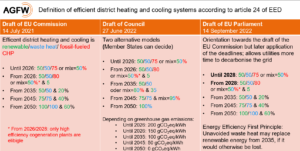What is in the Fit for 55 package for district heating?
February 13, 2023
With the Fit for 55 Package in July 2021 the European Commission started the revision of the EU´s core climate and energy directives. The revisions of two of them – the Renewable Energy Directive (RED III) and the Energy Efficiency Directive (EED) – have already arrived in the trilogue meetings, which is the phase when the European Parliament, the Council and the European Commission negotiate controversial points in an informal dialog to find compromises. The Energy Performance of Buildings Directive (EPBD) is five months behind and trilogue negotiations will most probably start in the first quarter of 2023. Decarbonisation of district heating plays an important role in all three directives. We have discussed the requirements and regulations for DH in RED, EED and EPBD with Raphael Schenkel, responsible for European Policy at the German District Heating Association, AGFW.
Chart: Fit for 55 package flyer see https://ec.europa.eu/commission/presscorner/detail/en/fs_21_3672
Binding and indicative targets within RED III
A compromise on important sector targets has already been found during the trilogue. Article 23 of RED III stipulates that Member States must increase the share of renewable energy in the heating and cooling sector by at least 1.1 percentage point as an annual average for the period up to 2030. This target is binding, whereas article 23 in RED II in 2018 requested Member States to achieve a non-binding annual increase of 1.3 percentage points.
The target in article 24 for district heating, however, is non-binding: “Member States shall endeavour to increase the share of energy from renewable sources and from waste heat and cold in district heating and cooling by an indicative 2.2 percentage points as an annual average calculated for the period 2021 to 2030.” In RED II the DH target was set at 1 percentage points.
Another important aspect of article 24 in RED III is paragraph 4a on third-party access to district heating networks. According to Schenkel the European Commission wanted to introduce an obligation to connect third party suppliers of renewable or waste heat to all DH grids above 25 MWth. But the Parliament changed the wording from “obliged” to “encouraged”. “In our opinion it is a good compromise that connections are not mandatory. Utility companies that have already invested in renewable or waste heat generation capacities need the possibility to weigh up the permission to feed in third-party heat economically. Otherwise, this would lead to an oversupply of heat capacity to the network, resulting in technical problems and higher prices for customers.”
Paragraph 2 in article 24 of RED III strengthens the rights of the district heating users. Customers have the right to disconnect if the existing heating network does not fulfil the criteria for efficient district heating or cooling and their alternative supply solution for heating or cooling results in a significantly better energy performance. “This regulation puts pressure on the DH operators to modernise their networks and decarbonise their heat generation plants, because otherwise they would lose heat customers,” said Schenkel.
Definition of efficient district heating and cooling systems in EED
In the recast of EED the definition of efficient district heating and cooling systems in article 24 is a key element. Member States shall ensure that where a district heating and cooling system is built or substantially refurbished it meets certain criteria. In the first phase, DH systems are considered efficient if they use one of these options: either at least 50 % renewable energy, 50 % waste heat, 75 % cogenerated heat or 50 % of a combination of such energy and heat. This has been taken over from the current version of EED. But according to the recast of EED, this definition is only valid for the short first phase of a few years.
In the second phase 50 % renewables or waste heat is still enough to fulfil the criteria, but cogenerated heat must already meet 80 % of the total heat demand in the heat network and be highly efficient. Following EED Annex III, CHP plants with a CO2 output of less than 270 grams per kWh of produced energy are considered to be highly efficient.
There is disagreement in Brussels about the deadlines for the first and second phases. Commission and Council would like to start the second phase (50%/50%/80%) already in 2026, but the Parliament suggested a later start – only from 2028 onwards.
The Commission and the Parliament agree that from the 1 January 2035, a DH system using at least 50 % renewable energy and waste heat, where the share of renewable energy is at least 20 % will fulfil the criteria of efficiency. The Council proposal allows high-efficiency co-generation with gas still until 2050. After that, CHP must run on green hydrogen or biomass. AGFW supports the scenario of the Council, in which high-efficiency gas-powered cogeneration can be used until 2050, as this is an important pillar of the current heat supply. All three institutions agree that after 2050 even high efficiency cogeneration cannot be used any more, so only renewables or waste heat are allowed in efficient district heating and cooling systems.
The EU Parliament’s draft revision included another aspect called the Energy Efficiency First Principle. According to this, unavoidable waste heat can replace the share of renewable energies from 2035 if it would otherwise be lost.

Definition of efficient district heating and cooling systems according to the drafts of the three EU institutions. Source: AGFW
EPBD uses efficient district heating to achieve zero emission buildings
“The EPBD is closely linked to RED and EED; all three directives are highly relevant for district heating. We would like to point out that the requirements for DH in EPBD and the definition of efficient DH in EED should not contradict one another”, said Schenkel. “District heating has a strong position within the EPBD and is explicitly named as a solution to supply heating for the future European building standard Zero Emission Buildings that will be mandatory for new buildings from 2028.”
There is currently disagreement between Council, Parliament and the Commission as to which requirements apply to district heating networks so that they can supply heat to zero emission buildings. The Council argues that the definition for efficient DH with increasing targets for renewable, waste and cogenerated heat (following EED) is enough, while the Commission only wants to allow renewable and waste heat networks without CHP.
Two years of transition time to be transposed into national law
What is the future schedule for the implementation of the directives? The trilogues for REDIII and EED are expected to be completed by April/May 2023. The trilogue for the EPBD must first start (approx. April), and then it will take at least six months. The final directive will therefore not be available until the end of 2023 at the earliest.
The member states then have two years to implement the regulations in the EU directives into national law. This will not happen until mid to late 2025.
Websites of organisations mentioned in this article:
https://www.agfw.de/ (in German)


